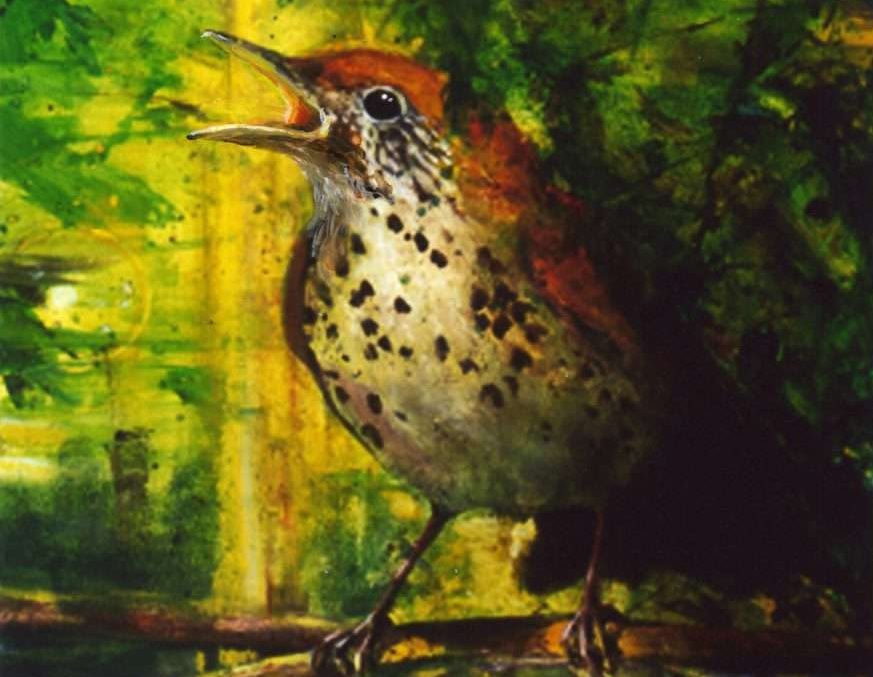 The shift begins around the time we turn the clocks ahead, a gradual transition from winter’s steady chorus of chickadees, squawking jays, and crows cawing over the compost pile to – well, more. On an afternoon walk along back roads, I’ll hear an avian uprising and look up to find a large flock of red-winged blackbirds gathered in the still-bare branches overhead.
The shift begins around the time we turn the clocks ahead, a gradual transition from winter’s steady chorus of chickadees, squawking jays, and crows cawing over the compost pile to – well, more. On an afternoon walk along back roads, I’ll hear an avian uprising and look up to find a large flock of red-winged blackbirds gathered in the still-bare branches overhead.
A week later, the trill-to-mechanical buzz of a song sparrow sounds from a hedge in the yard. Then, one early morning, the flutelike melody of a hermit thrush sifts through the cacophony of robins and juncos and pine warblers. By May, there will be a whole cast of birds hopping and chittering and flying about, as our summer songbirds return in waves.
For veteran birders, the spring migration season is a delight, with new bird species arriving – or passing through – daily, in yards and forests, fields and wetlands. For newer birders (or casual backyard bird watchers), this influx can be overwhelming.
What’s the best way to distinguish the song of a wood thrush from that of a hermit thrush? How do you identify a bird you can hear, but not see? And is there an easy way to differentiate one little brown bird (LBB) from another?
The key, according to Pamela Hunt, an avian conservation biologist with New Hampshire Audubon, is to learn in small, manageable steps over time. “Birding is like learning a language,” Hunt said. “Every little bit makes the next bit easier.”
I’ve found this to be true in my haphazard approach to bird watching. (I’m far too casual about it to call myself a true “birder,” although every species I learn brings a little more joy.)
As the spring mornings grow brighter and warmer, I take to sipping my coffee on the porch, enjoying the company of the birds as the sun rises over the mountains. I bring my small camera with a mid-range zoom, my binoculars, and my bird-call-app-loaded smart phone with me.
“There’s really no easy answer to picking through the cacophony of the dawn chorus – other than knowing all the instruments,” Hunt said. “It’s a matter of learning the songs – and when there are a bunch of them, sometimes they overlap. But the more you know the little nuances of each individual song, the more songs you can pick out.”
I’ve found Cornell Lab’s Merlin app to be helpful in identifying different bird songs. During peak spring migration, the “Sound ID” feature on Merlin might identify a dozen species in a minute of recording from my front porch.
Later, I can look up information – online and in my field guides – about the birds on that list that are unfamiliar to me, starting with confirming that the song I heard matches the ID Merlin suggests – but also what the bird looks like, its behaviors, and its habitat.
I find it helpful to snap a photo of an unfamiliar bird, when possible, to allow a more careful look at field markings – lines around the eye, say, or streaks on the breast, the presence of wingbars, the shape of its tail.
“A lot of birding is what we call GISS – general impression of size and shape,” Hunt said. “The first step is looking at the shape of the bird, the behavior of the bird. Does it have a pointy bill or a short bill? Does it hop around the ground or is it up in a tree? None of those are going to definitively tell you what specific species it is, but it starts narrowing things down. Once you narrow it down to a couple of species, you can hone in on specific field marks. It’s a continual process.”
Hunt recommends using a variety of tools to help learn the birds, from Merlin to printed field guides (Sibley and Peterson are two good options) to going on bird walks with a local Audubon chapter, Extension agency, or other birding group.
Whether birding alone or in a group, etiquette calls for keeping dogs on leash (or leaving them home altogether), minimizing talking, and not overusing playbacks of birdsong, which can be detrimental to birds who think the recordings are territorial interlopers.
Hunt often records the birds she sees on Cornell’s eBird database. This and other birding sites will be especially busy in the coming weeks.
“Now we’re in the middle of a migration with hermit thrush and a lot of sparrows and the first wave of warblers. Each day there are more species here,” she said. “In the middle of May, the floodgates open, with the warblers, the tanagers, grosbeaks, orioles, and flycatchers.”
I guess it’s time to brew the coffee, grab my binoculars, break out the field guides – and see what birds I can learn this season.
Meghan McCarthy McPhaul is the associate editor of Northern Woodlands. Illustration by Adelaide Murphy Tyrol. The Outside Story is assigned and edited by Northern Woodlands magazine and sponsored by the Wellborn Ecology Fund of the New Hampshire Charitable Foundation: www.nhcf.org.


